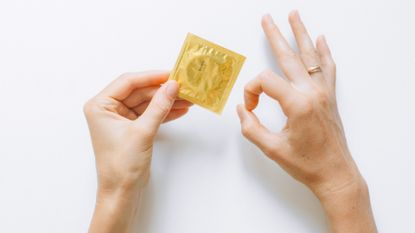Condom questions are natural. They're really very important things, whether you're looking to stop an unwanted pregnancy, protect yourself from an STI, or just leave the house prepared for anything. Having all the condom information you can leaves you prepared and ready for whatever might happen, be it casual condom use or something more long term.
So here's T3's titter-free guide to everything you always wanted to know about condoms but were afraid to ask. Once you're all clued up, you can head to our best condom guide for our top picks for all shapes, sizes and tastes.
- Condoms could make using the best dildos more hygienic
- Check out our pick of the best sex toys
- And why not treat yourself (or your partner) to one of the best Fleshlights?
Do condoms work?
How effective are condoms? Used every time and applied properly, condoms reduce the risk of pregnancy from 85% (no contraceptive) to 2%. Even used in a manner the textbook Contraceptive Technology calls 'typical' (which does appear to account for the heat of the moment somewhat) regular use of a condom will cut pregnancy chance to 15%. That might seem a worryingly high percentage, though do bear in mind that no contraceptive is 100% effective: even medical sterilisation leaves a trace chance of a stray sperm hitting its mark.
Overall, condoms are one of the best options there is, easily outperforming methods like the sponge, diaphragm, withdrawal and even the most accurate fertility tracker in preventing unwanted pregnancy.
- Browse the best lube – and remember to avoid oil-based options for use with condoms
Do condoms expire?
Condoms have a natural shelf life. Over time they'll dry out, which makes an expired condom weaker and more likely to break; typically a condom will have a lifespan of around three to five years, after which it should be thrown out and replaced.
Bear in mind that a number of factors will affect a condom's longevity, including storage (if it's been bouncing around in your wallet or bag for a while, tread carefully, and heat and humidity can play their role too), the material of the condom, and specific additives like spermicide which can reduce a condom's lifespan by as much as two years.
As a rule of thumb, if the package of the condom is scuffed or it's past its expiry date, abstinence is a far, far better option.

A well-stored, in-date condom is pretty safe. Careful of those nails, though...
Do condoms prevent STDs?
As with pregnancy, no condom is a 100% barrier. But the fact is that condoms, used properly, are a very effective way to prevent STIs.
Their precise effectiveness does vary depending on the disease or infection in question. Condoms are strongest against STDs which are transmitted by genital fluids – that's things like gonorrhoea, chlamydia, trichomoniasis, and HIV – and slightly less effective against skin-to-skin infections like genital herpes, HPV and syphilis given that they may not cover every area of skin.
In general though, this is a big yes, and a huge advantage over contraceptives which do not form a physical barrier.
How should condoms fit?
The best condom is one which fits perfectly – not too tight, not too loose, not too long or short. It should be snug, cover the entire length of the shaft, and not move around too much once applied. The reasons for this should be pretty obvious: you absolutely don't want a condom slipping off while you're using it, or being so tight as to add unwanted tension and friction which could cause it to break – and a condom which covers less skin is less effective against preventing STIs.
There's no one condom and no one penis size, of course, though condoms are generally shaped well enough to fit snugly in most cases – certainly to the point of reducing risk.
Do condoms have sizes?
Condoms come in all shapes and sizes to help with that perfect fit. Some, like My.Size, allow you to measure yourself (or your partner) and buy a specific size perfectly suited to them; other manufacturers tend to offer a variety of sizes throughout their range. Durex, for example, offers smaller condoms in its Ultra Thin and Invisible varieties, which are each 52mm in diameter, a broader range with a 56mm diameter, and a specific Comfort XL variety with a little extra length and a chunkier 57mm diameter.
Shape can matter too. Some condoms have a larger tip, suitable for chaps with a bigger glans or those who can't stand any tightness in that most sensitive area. If you're looking for something that'll work for you, whip out that tape measure and check our guide to the best condoms to find your perfect fit.

One size fits all? Even if you're more a chilli pepper than an aubergine, there's something out there for you
Are condoms vegan?
Not all condoms are vegan, but many are. The issue is the protein casein, found in milk, which is often used to make latex more supple. Many latex condoms contain casein, but progressively more are beginning to use a vegan alternative – it's absolutely worth checking on a casein by casein basis (sorry).
Latex is not the only material used for condoms, though, and materials like polyisoprene do not require casein at all. If you pick up a non-latex condom, you're almost guaranteed that it'll be vegan.
Do condoms have spermicide?
Some condoms do contain spermicide. This is a contentious ingredient, given that spermicide (particularly Nonoxynol-9, the most common) can actually reduce the effectiveness of condoms and in some cases, increase the likelihood for STD transmission. That said, if you're using condoms in a stable relationship, spermicide may actually be an appealing extra line of defence against unwanted pregnancy.
Which condoms have spermicide? That depends on where you live: in the UK it's very hard to find condoms with spermicide – in the US, look for certain varieties of Trojan, which should be clearly marked. It's always worth checking the packet, wherever you live.
When were condoms invented?
There's no way of putting a precise date on the invention of condoms – archaeologists can't seem to agree if they were used in antiquity or not. We do know that there's evidence in Asia of glans-only condoms dated around the 15th century, made of oiled paper and lamb intestines in China or the slightly rougher-sounding tortoiseshell or animal horn in Japan. Presumably the thought of using one was contraceptive enough.
The shape we know today originated in the 16th century in the form of a treated linen sheath designed to reduce the spread of syphilis, and the first references to condoms being used for birth control come at the beginning of the 17th century, at which point animal intestines and bladders began to take over as a material.
The modern condom had to wait until Charles Goodyear got his head around rubber; the first latex condom arrived around 1880.










